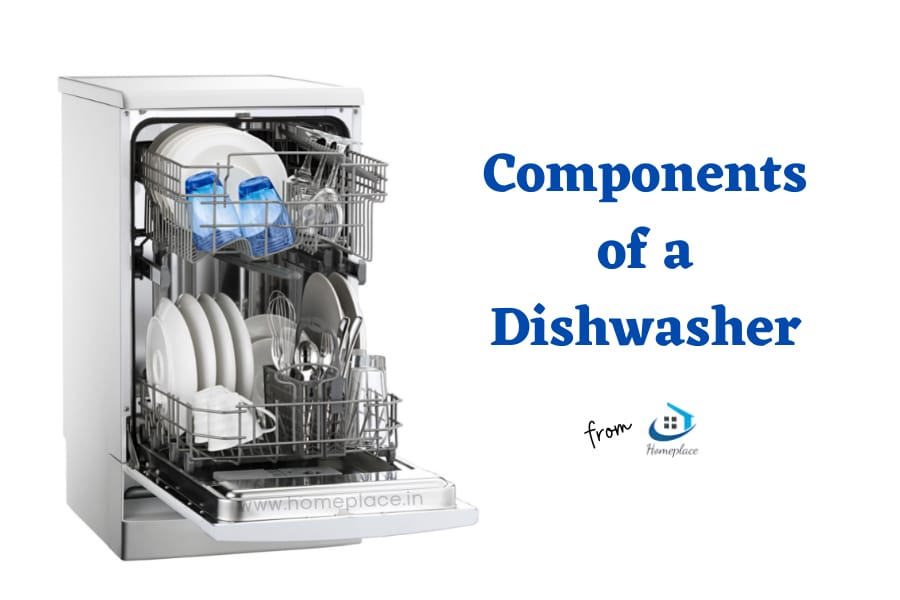If you are new to a dishwasher, it is essential to know about its mechanism to make it work. But it is not very complicated when it comes to washing dishes. Most of the basic working functions rely on detecting the number of dishes present on the racks to clean them.
The necessary thing you have to remember about the dishwashers is to load the detergent on time. Make sure to use the proper detergent that is compatible with your dishwasher. While installing, the mechanic connects the appliance to the water supply.
Components of a Dishwasher and their Functions
Are you aware of what makes up a dishwasher?
When you buy an electronic appliance, it is always good to know a bit about the parts. It allows easy troubleshooting at times of need.
Besides that, knowing about the components gives you a detailed idea of the device’s working process. Hence, let us know a bit more about the essential components of dishwashers.

Heating Element
The most preliminary component of a dishwasher is its heating element. This is the part that heats the water used in cleaning the plates. Hot water is excellent at removing greases and germs.
Another task of the heating element is to provide heated dry air. It helps in drying your utensils once the wash cycle is over. The hot air also prevents rust and mold formation.
Inlet Valve and Drain Valve
The Inlet Valve is the mouth of water’s source into your dishwasher. While setting up a dishwasher, the inlet valve is attached to a tap or a similar water source.
Similarly, when a wash cycle is complete, the drain valve opens up to let water escape the dishwasher. It is usually attached to a pipe and a filtration system.
Circulation Pump and Motor
Water needs to enter a dishwasher for the utensils to get cleaned. So, the motor allows the dishwasher’s pump to introduce water during a cleaning cycle.
Spray Arms
The circulation pump in the dishwasher is often attached to the spray arms. These arms help in evenly distributing the water throughout the dishwasher. They have different designs according to the specific brand. Rather than filling up water in a washing machine, the water is sprayed into a dishwasher for cleaning.
Dispenser
You have to put detergent in the dishwasher to provide the appliance with a cleaning agent. After you place it in a dispenser, the appliance uses it smartly. Every brand has its own way of programming the dispenser.
Dish Racks
You will find metal racks or drawers in your dishwasher, which are easily removable. These racks also have places for your distinct utensils. The shelves help your utensils to stay in their place while they are being cleaned.
Sometimes even an extra rack is provided for loading the delicate items. In general, there are two rack levels in the dishwasher.
Operating Touchpad
A touchpad helps to program your dishwasher. It’s made up of tactile or touch buttons with pre-set options. Every brand has its own way of structuring the programming panel.
Most dishwashers also come with a small display to show time and settings. Fancier dishwashers can also have settings like a dial and manual programming.
Door Latch
To keep things safe and secure, a door latch is added to the dishwasher. Without a proper door latch, your appliance wouldn’t start. This prevents any accidents caused by improper closing of an appliance’s door.
Filtration System
The filtration system keeps the outlet of the dishwasher free from blockages. It’s essential to clean larger food debris before loading utensils. However, some might persist. So, a good filtration system is crucial.
Float Bulb and Switch
Safety and precautions are always welcomed in the case of home appliances. Have you ever thought about how overflowing might be contained? In dishwashers, float bulbs, and switches make the magic happen.
If there is an overflow, the float bulb detects it and the float switch ceases the water flow. These are generally present in the front corner of the dishwasher.
These are the main components and functions of a dishwasher. Several other minute components help to run the appliance smoothly. Always make sure to use the original components of a brand in case of replacements.

The Working Principle of dishwashers
When you turn on the dishwasher, it draws water from the supply and then heats it. The temperature is generally between 45°C and 75°C or 110°F and 170 °F. A sensor triggers the detergent, which will be sprayed on the dishes. As soon as you start the machine, the cleaning tablet generally falls to get mixed with the water.
There are holes for supplying water, that are spread with the help of two paddles. One paddle is on the top of the dishwasher, whereas another one is at the bottom—these jets of water help in cleaning the dishes.
While you are loading the utensils, check if they are compliant with the dishwasher. Most dishwasher-friendly utensils also state the rack where you should place them. The lower rack is generally hotter as it is closer to the source of water.
They have often had two cycles of spraying the detergent mixed water. It helps in cleaning, and the dishes come out completely clean. The food pieces are pumped out of the machine, or they are caught in the sieve. You should always be careful not to leave very big food items on the utensils before loading them into a dishwasher.
The heat generated inside the machine dries off the dishes. You should be careful not to overload the machine. In every dishwasher, there is a panel that lets you choose the type of cycle and the length of it. Every company has different settings, so study well about a suitable dishwasher.
How does it differ from other washing appliances?
So, a dishwasher works easily without much manual intervention. Many people compare it to washing machines, but unlike them, a dishwasher is never loaded with water. Instead, water is sprayed through the racks to clean the dishes. Sensors are crucial in dishwashers as they regulate the temperature as well as the water required. Some newer models even have sensors to detect the dirtiness level of the plates.
Related Posts:
